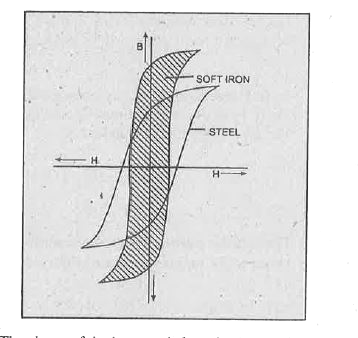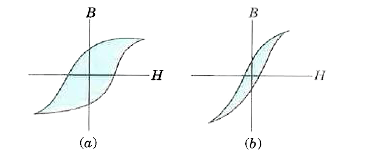Explain the magnetic hysteresis loop ? What are its uses ?
(a) Hysteresis. The lagging of intensity of magnetisation behind the magnetising field is called hysteresis. To explain term hysteresis, suppose a bar of iron is magnetised slowly. The intensity of magnetisation M increases with increase in the strength of magnetising field along OA as shown in the figure. At A, any further increase in H does not produce any increase in M and therefore, corresponding to point A, the bar has acquired a state of magnetic saturation. If the magnetising field is now decreased slowly, the intensity of magnetisation also decreases but corresponding to point B when H becomes zero the intensity of magnetisation does not become zero.
The value of intensity of magnetisation retained by the magnetic material, even when the magnetising field is reduced to zero is called its retentivity or remanent magnetism or residual magnetism.
Thus, OB represents the retentivity of the material under study. If now the direction of magnetising field is reversed, the intensity of magnetisation reduces along BC till it becomes zero at C. Thus to reduce the residual magnetism to zero, magnetising filed equal to OC has to be applied in reverse direction.
The value of the reverse magnetising field which is to be applied to the magnetic material so as to reduce the residual magnetism to zero is called its coercivity.

When the magnetising field is further increased in reverse direction, the intensity of magnetisation increases along CD till corresponding to point B, it again acquires saturation value symmetrical to point A. On increasing the field again, the intensity of magnetisation follows the path DEFA, and the closed curve ABCDEFA is obtained for complete cycle of magnetisation. This closed curve is known as hysteresis loop. On repeating the process, the same closed curve is obtained again and again but portion OA is never obtained.
Corresponding to point B, H is zero but M has still some finite value and becomes zero after increasing H in reverse direction. Therefore, intensity of magnetisation does not become zero on making magnetising field zero but does so a little and this effect is called hysteresis.
(b) Uses. When a ferromagnetic substance is taken over a complete cycle of magnetisation, the energy spent per unit volume is numerically equal to the area of the hysteresis loop.

1. The shape of the hysteresis loop is characteristic of the magnetic materials. For example, for soft iron, the hysteresis loop is narrow and large in height, while that for steel, it is quite wide and small in height, while that for steel, it is quite wide and small in height, [as shown in the fig.] The area of hysteresis loop for soft iron is found to be much smaller than for steel. Due to this, the loss of energy in case of soft iron bar will be very small as compared to that in case of steel, when both are taken over complete cycle of magnetisation. On account of this, soft iron is used to make the core of transformers and generators. Silicon, iron and mumetal (76% nickel, 17 % iron and small percentage of copper and chromium) also possess narrow hysteresis loop and can be used to make the core of a transformer.
2. Due to high value of coercivity and fairly large value of retentivity, steel is used to make permanent magnets. The area of hysteresis loop is large for steel but it is of no consideration as a permanent magnet has never to be taken through a cycle of magnetisation. Materials suitable for making permanent magnets are cobalt steel (containing cobalt, tungsten and carbon) chromium, steel, tungsten steel. The alloy alnico (54% iron, 18% nickel, 10% aluminium, 12% cobalt, and 6% copper) is also very suitable for making permanent magnets. The only disadvantage is that alnico is brittle.
3. For soft iron, coercivity is very small and area of hysteresis loop is very small. Because of these characteristics soft iron is an ideal material for making electromagnets.
Topper's Solved these Questions
- MAGNETISMBook:MBD -HARYANA BOARDChapter:MAGNETISMExercise:OBJECTIVE TYPE QUESTIONS
Explore 17 Videos
- MAGNETISMBook:MBD -HARYANA BOARDChapter:MAGNETISMExercise:SHORT ANSWER TYPE QUESTIONS
Explore 4 Videos
- ELECTROSTATICSBook:MBD -HARYANA BOARDChapter:ELECTROSTATICSExercise:OBJECTIVE TYPE QUESTIONS
Explore 23 Videos
- MODEL TEST PAPER (SOLVED)Book:MBD -HARYANA BOARDChapter:MODEL TEST PAPER (SOLVED)Exercise:LONG ANSWER TYPE QUESTIONS
Explore 6 Videos
Similar Questions
Knowledge Check
The area enclosed by a hysteresis loop is a measure of
AretentivityBsusceptibilityCpermeabilityDenergy loss per cycle
'A system displaying a hysteresis loop such as a ferromagnet, is a device for storing memory.' Explain the meaning of this statement.
View SolutionExplain the phenomenon of hysteresis in magnetic materials.
View SolutionWhat is meant by hysteresis loss? Where is the study of hysteresis used?
View SolutionThe area enclosed by a hysteresis loop is a measure of
View SolutionThe area enclosed by a hysteresis loop is a measure of
View SolutionAnswer the following question: (a) Explain qualitatively on the basis of domain picture, the irreversibility in the magnetisation curve of a ferromagnet.
(b) The hysteresis loop of a soft iron piece has a much smaller area than that of a carbon steel piece. If the material is to go through repeated cycles of magnetisation, which piece will dissipate greater heat energy?
(c) A system displaying a hysteresis loop such as ferromagnet is a device for strong memory? Explain the meaning of this statement.
(d) What kind of ferromagnet material is used for coating magnetic tapes in a cassette player, or for building memory stores in a modern computer?
(e) A certain region of space is to be shielded from magnetic fields. Suggest a method.
View SolutionWhich material would make a better permanent magnet, one whose hysteresis loop looks like figure (a) or one whose loop looks like figure (b)?

View Solution


